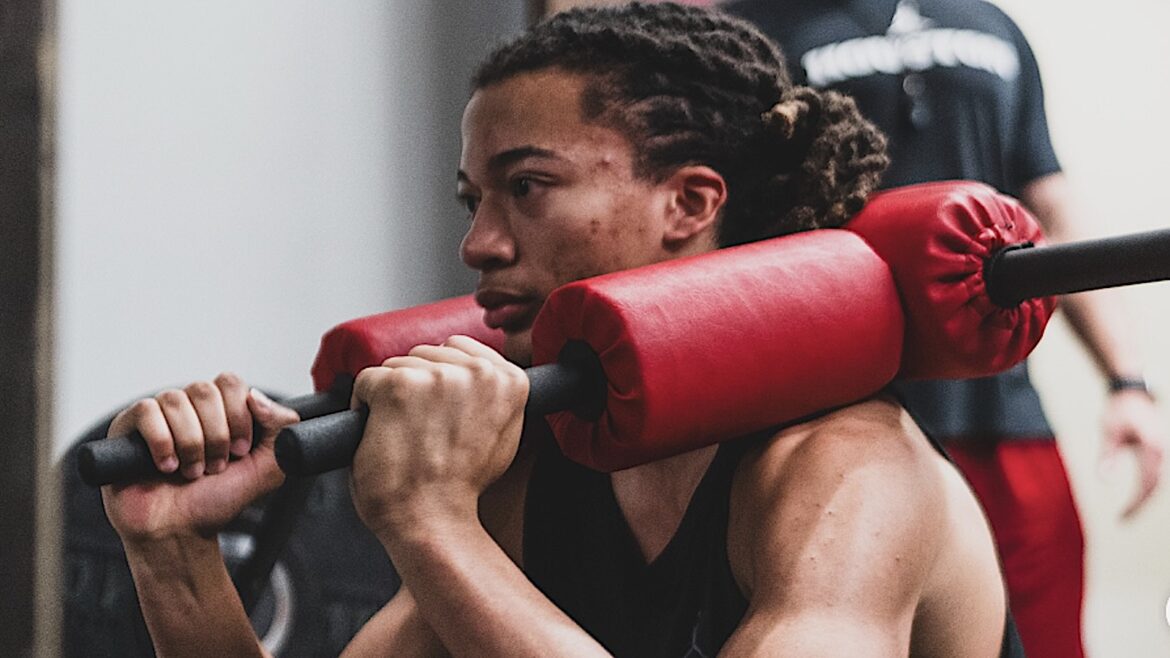Alan Bishop on how deep squats boost performance and protect players on the court.
As the director of Sports Performance for the University of Houston men’s basketball team, Alan Bishop’s transformative approach to the strength and conditioning program has helped the Cougars reach the Sweet 16 for the past six years.
In mid-August 2025, Bishop held a seminar on deep squat training, showing how a full range of motion (ROM) can enhance athletic performance and reduce injury risk.
Why Deep Squats Matter for Basketball
Ankle mobility is a top priority on the court for pivoting and crossing over. The Achilles tendon needs strength and stability for jump shots. A deeper ROM is linked to better ankle flexion. (1)
A healthy body, with mobility at the ankle and stability at the knee is an injury prevention mechanism.
—Alan Bishop
Studies have shown that ankle mobility and Achilles tendon strength directly affect vertical jump mechanics, helping athletes block shots and rebound the ball more effectively. (2)
Ankle mobility impacts balance, boosts longevity, and improves quality of life. (3) Functional ankles reduce the risk of chronic injury. (4)
Bishop’s Four-Step Squat Progression
Bishop’s four-step squat progression reshaped how his basketball players train, focusing more on joint and muscle strength.
Tall basketball players often avoid deep squatting due to fears of knee strain or biomechanical trouble, but Bishop’s framework is steady progression to remedy those concerns.
Movement quality is going to be what dictates how you load down the road.
—Alan Bishop
- Hands-Free Front Squat: Using a slant board with heels elevated, perform five-second eccentrics and one-second pauses at the bottom.
- Flat Ground Hands-Free Squat: Elevate heels with a vertical torso for maximum quad activation.
- Front Squat
- Back Squat
More Powerlifting Content
References
- Gomes J, Neto T, Vaz JR, Schoenfeld BJ, Freitas SR. Is there a relationship between back squat depth, ankle flexibility, and Achilles tendon stiffness? Sports Biomech. 2022 Aug;21(7):782-795. doi: 10.1080/14763141.2019.1690569. Epub 2020 Feb 5. PMID: 32022631. https://pubmed.ncbi.nlm.nih.gov/32022631/
- Terada M, Pfile KR, Pietrosimone BG, Gribble PA. Effects of chronic ankle instability on energy dissipation in the lower extremity. Med Sci Sports Exerc. 2013 Nov;45(11):2120-8. doi: 10.1249/MSS.0b013e31829a3d0b. PMID: 23660591. https://pubmed.ncbi.nlm.nih.gov/23660591/
- Liang SG, Chow JCM, Leung NM, Mo YN, Ng TMH, Woo CLC, Lam FMH. The Effects of Ankle and Foot Exercises on Ankle Strength, Balance, and Falls in Older People: A Systematic Review and Meta-Analysis. Phys Ther. 2025 Jan 8;105(1):pzae157. doi: 10.1093/ptj/pzae157. PMID: 39657220. https://pubmed.ncbi.nlm.nih.gov/39657220/
- van der Wees PJ, Lenssen AF, Hendriks EJ, Stomp DJ, Dekker J, de Bie RA. Effectiveness of exercise therapy and manual mobilisation in ankle sprain and functional instability: a systematic review. Aust J Physiother. 2006;52(1):27-37. doi: 10.1016/s0004-9514(06)70059-9. PMID: 16515420. https://pubmed.ncbi.nlm.nih.gov/16515420/
Featured image: @coachalanbishop on Instagram
